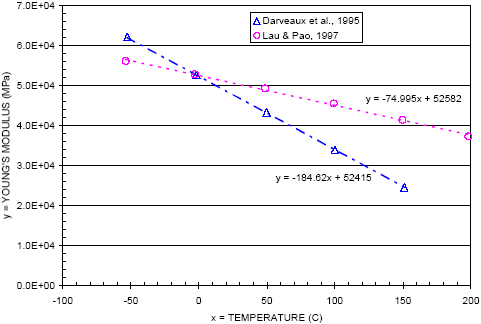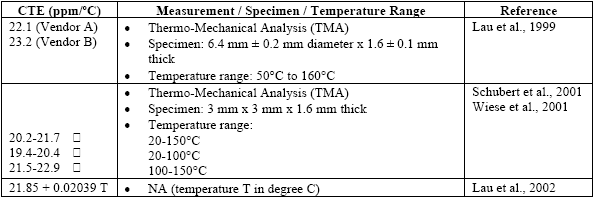| Other Properties
of Sn-3.5Ag
Young's Modulus vs. Temperature |
 |
|
Figure
22: Plot of Sn3.5Ag Young's Modulus E (MPa) versus
temperature T (°K).
Young's modulus versus temperature is plotted in Figure
22, similar to Figure 9 in Wiese et al., 2001. The original
source of the data was publications by Darveaux et al. (1995)
and Lau & Pao (1997). The data was digitized and, for
each dataset, we added a linear trendline and its equation
so the temperature-dependence of Young's modulus is readily
available. The temperature-dependent Young's modulus is entered
as material properties in stress / strain analysis programs
such as FEA codes. Young's modulus is also used to scale steady-state
stresses in some creep rate models.
Poisson's Ratio
Another elastic property that is of use in stress/strain
analysis programs or to convert Young's modulus E to a shear
modulus, G, is Poisson's ratio. Lau et al. (2002) used a Poisson's
ratio n = 0.4 in the finite element modeling of Sn3.5Ag assemblies.
We were not able to locate any report with direct measurements
or experimental determination of Poisson's ratios for Sn3.5Ag
alloy.
Coefficients of Thermal Expansion
(CTE)
|
 |
| Table
9: Sn3.5Ag CTE values.
Measured or quoted Coefficients of Thermal Expansion (CTEs)
for the Sn3.5Ag alloy are given in Table 9. As expected, the
CTE results show a slight temperature dependence. From the
data in Table 9, an overall average value for the CTE of Sn3.5Ag
is about 21.5 ppm/°C.
For comparison purposes, a value that is often quoted for
the CTE of eutectic SnPb is 24 ppm/°C. The CTE of Sn-3.5Ag
appears to be slightly lower than that of eutectic SnPb. This
is beneficial to solder joint reliability, in general, since
a lower CTE of the solder alloy reduces local CTE mismatches
between the solder joint and the interconnected parts.
Other Physical Properties
Other properties of interest for predictive modeling of
solder joint geometry using, for example, a computer program
such as Surface Evolver, are:
- Solder density,
 in lb/in3 (or g/cm3).
in lb/in3 (or g/cm3).
|
| |
 (g/cm3).
= 7.5 (NIST Boulder database). (g/cm3).
= 7.5 (NIST Boulder database). |
| |
|
- Note that an error seems to have propagated through the
literature since both the ITRI publication (No. 656) and
the GE / DeVore handbook quote
 = 10.38 g/cm3 for Sn-3.5Ag.
= 10.38 g/cm3 for Sn-3.5Ag.
- The NIST-quoted value is consistent with the rule of
mixture calculation:
 = 96.5%
= 96.5%  Sn
+ 3.5% Sn
+ 3.5%  Ag,
where the density of pure Sn and Ag are Ag,
where the density of pure Sn and Ag are  Sn
= 7.31 g/cm3 and Sn
= 7.31 g/cm3 and  Ag
= 10.5 g/cm3, gives: Ag
= 10.5 g/cm3, gives:  Sn-3.5Ag
= 7.42 g/cm3. Sn-3.5Ag
= 7.42 g/cm3.
|
| |
- Surface tension,
 ,
in units of mNm-1, to be specified in terms of
the soldering atmosphere (e.g., air, nitrogen…): ,
in units of mNm-1, to be specified in terms of
the soldering atmosphere (e.g., air, nitrogen…):
|
| |
|
 = 431 mNm-1 in air, g = 493 mNm-1
in nitrogen (at 50°C above liquidus), after Glazer (1994)
& quoted in NIST-Boulder database.
= 431 mNm-1 in air, g = 493 mNm-1
in nitrogen (at 50°C above liquidus), after Glazer (1994)
& quoted in NIST-Boulder database. |
| |
- Thermal conductivity, k in units of W/m°K, is also
used for heat transfer analysis: NA.
|
|
Missing values or additional measurements of the above physical
properties will be added to the material property database
when the data is available. |
|
